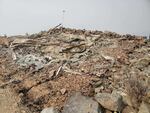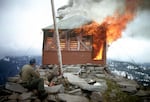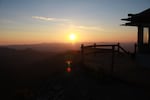This summer, the nonprofit Siskiyou Mountain Club will work with the U.S. Forest Service to reconstruct the Bolan Mountain Fire Lookout in southern Oregon, a historic cabin that burned to the ground in the 2020 Slater Fire.
The iconic fire lookout once perched on Bolan Peak just north of the California-Oregon border. A small, 14-by-14-foot cabin with four walls of windows and a wrap-around deck, it offered a sweeping vantage of the Siskiyou Mountains.

Perched on a rocky peak at 6,242 feet of elevation, the Bolan lookout offered a sweeping view of the Siskiyou Mountains. Photo taken in 2018.
Alex Moore
Bolan Peak served as a remote Forest Service outpost to spot and report forest fires starting in 1917. In 1953, the original lookout was replaced with an “L-4″ style structure, the iconic cabin that is commonly associated with lookouts in the Northwest of the 1930s and 40s. More recently it had been one of Oregon’s incredibly in-demand overnight recreational rentals.
Bolan was the only lookout on the Wild Rivers district of the Rogue River-Siskiyou National Forest available for the public to rent overnight, and one of only 13 available in Oregon. Like other lookouts in the rental program, Bolan was so popular that it was booked with 100% occupancy.
“It’s hard to describe how unique and special a place like Bolan lookout was,” said Scott Blower, District Ranger for the Wild Rivers Ranger District. “To the west, you could see whitecaps of the ocean, and to the east the sunrise over Mount McLoughlin. At night, there’s not a single light anywhere around, so to see the stars at night is incredible.”
In 2020, the historic lookout had just undergone repair. Then, that Labor Day weekend, a windstorm fanned the flames of wildfires along the Cascade Range, creating a series of hugely destructive “megafires” greater than 100,000 acres in size, including Beachie Creek, Holiday Farm, Lionshead, Riverside, and the Slater Fire, which incinerated the Bolan lookout. Altogether, the fires burned more than a million acres across Oregon, destroyed thousands of homes and killed nine people.
District Ranger Scott Blower, who initiated the Bolan lookout rebuilding project, grew up in the region. For him, the lookout tower had personal memories. He fondly recalls coming to the lookout with his father and grandfather during deer hunting season to eat lunch and take in the view. He’s looking forward to seeing the tower rebuilt this year because he wants to create more memories there to share with his son.
“This is a place that is so dear to the district, as well as myself, personally,” he said. “Slater impacted a lot of people. This project is a sign of hope and resiliency.”

The historic Bolan Mountain Lookout tower was reduced to a pile of rubble by the 2020 Slater wildfire.
US Forest Service, Rogue River-Siskiyou National Forest
Forest Service budgets and staff size have been dramatically reduced over the past decades, Blower notes, and to tackle a project like restoring a historic lookout requires finding both specialized funding and a willing partner.
He found a collaborator in Gabe Howe, executive director of the Siskiyou Mountain Club.
Since 2010, the Siskiyou Mountain Club has built a reputation for restoring the trails of southwest Oregon.
The nonprofit will help restore trails around the lookout area, as well as lead the rebuilding of the lookout.
“When I got into this work 14 years ago, it was about rebuilding the trails, opening up access for other people to this wild place I loved,” Howe said. “This is new for us to tackle a building, but I’m all about getting the next generation out onto public lands, whether that’s through a campground, a lookout, or a historic guard station.”
Howe’s father, who has a background in construction, is volunteering to help coordinate with various contractors.
The club is looking for volunteers to join work parties. One will be to help haul materials on location, and another to paint siding at the Forest Service facilities in Cave Junction, that will then go to the lookout.
The new lookout will be rebuilt with updated engineering specs to modern code, including steel structural support, a metal roof, and fire resistant materials. Its wood-clad interior and cedar siding will help give it the iconic characteristics of a historic fire lookout.
“We’re doing everything we can to maintain that look and feel of that L-4 lookout from 1953,” Blower said. “We just want to keep it maintainable and a little more resistant to fire.”
Following the devastating fires of 1910, the Forest Service set spotting fires as a high priority, according to the Forest History Society. Lookout towers began to be built on national forests throughout the country, especially in the Pacific Northwest. During the Great Depression, the Civilian Conservation Corps aided these efforts by building numerous lookouts.
By the end of the 20th century, advances in technology, the growing infrastructure of forest roads, and changing policy on fire management made staffing the remote outposts less essential, and many lookouts were abandoned. Those left became targets of vandals. Others were intentionally burned to the ground by the Forest Service, which saw the buildings as tools that were no longer needed and had become liabilities.

A Forest Service employee takes a lunch break as he watches the East Zigzag Mountain Lookout burn in 1965. Many lookouts were intentionally destroyed on national forests after they were no longer needed for fire detection purposes. In the 1980s, some of the surviving lookouts found a new role in outdoor recreation as overnight rentals.
US Forest Service, Mt Hood National Forest Archives
There are 167 Oregon lookouts on the National Historic Lookout Register, but the designation is more of an inventory and does not mandate preservation. This loss is part of a much larger loss of historic lookouts in the American west. Every year, the Forest Fire Lookout Association reports on lookouts lost — mostly to wildfire, vandalism, and also to eventual collapse from lack of maintenance and use.
In 2021, Oregon lost one of its most iconic lookouts to wildfire, the Bull of the Woods.
As the number of lookouts have declined, their popularity has grown exponentially. Although some are still seasonally staffed for fire detection, the Forest Service has found a new value for them as recreational resources. They’re so in demand that some people try for years for an opening to reserve one.
Blower said that’s just one of the reasons it’s important to restore the Bolan lookout.
“Putting the lookout back preserves our history as land managers,” Blower said. “But more importantly is what it offers visitors now.”
Blower hopes the collaboration between the Wild River ranger district and the Siskiyou Mountain Club will be a model for other national forests in the Northwest. The plan is to complete the lookout this summer and once again make it available for the public to experience.

A view of the sunset from the Bolan lookout in southern Oregon before the structure burned in the Slater Fire in 2020.
US Forest Service, Rogue River-Siskiyou National Forest
